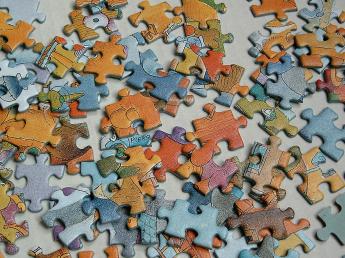Jigsaw puzzle
|
|
A jigsaw puzzle is a tiling puzzle that requires the assembly of numerous small, often oddly-shaped, interlocking pieces. Each piece has a small part of a picture on it; when complete, a jigsaw puzzle produces a complete picture. People solve jigsaw puzzles as a hobby.
Jigsaw puzzles were originally created by painting a picture on a flat, rectangular piece of wood, and then cutting that picture into small pieces with a jigsaw, hence the name. John Spilsbury, a London mapmaker and engraver, is credited with creating the first jigsaw puzzle around 1760.
Most modern jigsaw puzzles are made out of cardboard, since they are easier and cheaper to mass produce. An enlarged photograph or printed reproduction of a painting or other two-dimensional artwork is then glued onto the cardboard before cutting. The pieces are punch-cut with complex metal dies.
Typical images found on jigsaw puzzles include scenes from nature, buildings, and repetitive designs. Castles and mountains are two traditional subjects.
| Contents |
Variations
Jigsaw puzzles typically come in 500-piece, 750-piece, and 1,000-piece sizes; currently the biggest commercially available size is 18,000 pieces. The most common layout for a thousand-piece puzzle is 38 pieces wide by 27 pieces, for a total count of 1,026 pieces. The majority of 500-piece puzzles are 27 pieces by 19 pieces.
Children's jigsaw puzzles come in a great variety of sizes, rated by the number of pieces.
A few puzzles are made double-sided, so that they can be solved from either side, which adds a level of complexity, because one can't be certain that the correct sides of the pieces are being viewed.
There are also three-dimensional jigsaw puzzles. Many of these are made of wood and require the puzzle to be solved in a certain order; some pieces will not fit in if others are already in place. Also common are puzzle boxes: simple three dimensional jigsaw puzzles with a small drawer or box in the center for storage.
Puzzle pieces
The method of cutting pieces varies from puzzle line to puzzle line. Many puzzles are termed "fully interlocking". This means that adjacent pieces are connecting such that if you move one piece horizontally you move all, preserving the connection. Sometimes the connection is tight enough to pick up a solved part holding one piece.
Some fully interlocking puzzles have pieces all of a similar shape, with rounded tabs out on opposite ends, with corresponding blanks cut into the intervening sides to receive the tabs of adjacent pieces. Other fully interlocking puzzles may have tabs and blanks variously arranged on each piece, but they usually have four sides, and the numbers of tabs and blanks thus add up to four.
Some puzzles also have pieces with noninterlocking sides that are usually slightly curved in complex curves. These are actually the easiest puzzles to solve, since fewer other pieces are potential candidates for mating. However, a solved part is easily disturbed by accidental shock etc.
The uniform-shaped fully interlocking puzzles are the most difficult, because the differences in shapes between pieces can be very subtle. Occasionally, some puzzles have bizarre cuts to make solving more interesting.
Two puzzles of the same size and series from the same manufacturer usually have exactly the same cut, since the cutting dies are complex and expensive to make and so are used repeatedly from puzzle to puzzle. This enables disparate puzzles to be combined in odd ways. Bigger puzzles commonly are also divided into two or more sections, sometimes rotated against each other, that were cut with the same standard-sized die.
Trivia
- Some people glue completed puzzles to a backing for permanent display. This is a fairly rare practice today, but was more common at a time when puzzles were more of a novelty.
- Puzzle manufacturers sponsored National Jigsaw Puzzle Championships for several years in the 1980s and in 1990. They were held in Athens, Ohio.
See also
External links
- The First Jigsaw Ever Sold (http://www.bl.uk/whatson/exhibitions/lieland/m3-2-1.html), from the British Library website
- Online Puzzles (http://www.jigsawpuzzles.ws/) (Java-based), from an anonymous ad-supported website
- Online Puzzles (http://www.wehmingen.de/englisch/games/) (Flash-based), from the website of the Hannover Tramway Museum
- National Jigsaw Puzzle Championships (http://home.att.net/~mike_helland/njpc.html), from the personal website of a puzzle enthusiastde:Puzzle
es:Puzzle eo:Puzlo fr:Puzzle it:Puzzle ja:ジグソーパズル ms:Jigsaw puzzle nl:Legpuzzel sv:Pussel

